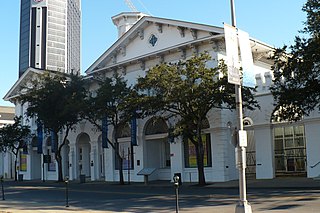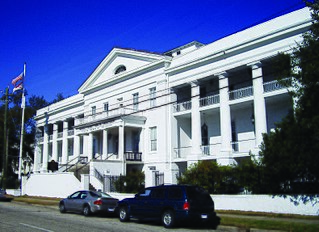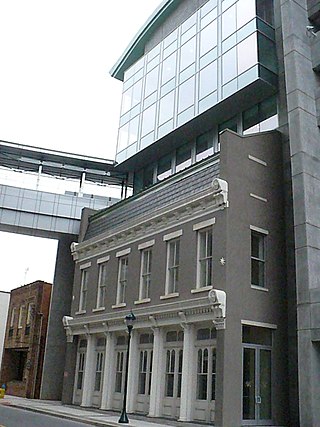
Mobile is a city and the county seat of Mobile County, Alabama, United States. The population within the city limits was 187,041 at the 2020 census, down from 195,111 at the 2010 census. After a successful vote to annex areas west of the city limits in July 2023, Mobile's population increased to 204,689 residents. It is now the second-most-populous city in Alabama, after Huntsville.

Cahaba, also spelled Cahawba, was the first permanent state capital of Alabama from 1820 to 1825, and the county seat of Dallas County, Alabama until 1866. Located at the confluence of the Alabama and Cahaba rivers, it suffered regular seasonal flooding.

Bienville Square is a historic city park in the center of downtown Mobile, Alabama. Bienville Square was named for Mobile's founder, Jean-Baptiste Le Moyne, Sieur de Bienville. It takes up the entire block bordered by the streets of Dauphin, Saint Joseph, Saint Francis, and North Conception.

Old City Hall, also known as the Southern Market, is a historic complex of adjoining buildings in Mobile, Alabama, that currently houses the History Museum of Mobile. The complex was built from 1855 to 1857 to serve as a city hall and as a marketplace. It was declared a National Historic Landmark in 1973, as a rare well-preserved example of a 19th-century multifunction civic and commercial building.

Government Street Presbyterian Church in Mobile, Alabama is one of the oldest and least-altered Greek Revival church buildings in the United States. The architectural design is by James Gallier Sr., James H. Dakin, and Charles Dakin. The trio also designed Barton Academy, four blocks down Government Street to the west. Government Street Presbyterian reflects the influences of Ithiel Town, Minard Lafever, and Andrew Jackson Downing. It was declared a National Historic Landmark in 1992.

Magnolia Cemetery is a historic city cemetery located in Mobile, Alabama. Filled with many elaborate Victorian-era monuments, it spans more than 100 acres (40 ha). It served as Mobile's primary, and almost exclusive, burial place during the 19th century. It is the final resting place for many of Mobile's 19th- and early 20th-century citizens. The cemetery is roughly bounded by Frye Street to the north, Gayle Street to the east, and Ann Street to the west. Virginia Street originally formed the southern border before the cemetery was expanded and now cuts east–west through the center of the cemetery. Magnolia contains more than 80,000 burials and remains an active, though very limited, burial site today.

Creole architecture in the United States is present in buildings in Louisiana and elsewhere in the South, and also in the U.S. associated territories of Puerto Rico and the U.S. Virgin Islands. One interesting variant is Ponce Creole style.

The Conde–Charlotte House, also known as the Kirkbride House, is a historic house museum in Mobile, Alabama. The earliest section of the building, the rear kitchen wing, was built in 1822. The main section of the house was added a few decades later and is two and a half floors. The entire structure is constructed of handmade brick with a smooth stucco plaster over the exterior.
The Old Dauphin Way Historic District is a historic district in the city of Mobile, Alabama, United States. It was named for Dauphin Way, now known as Dauphin Street, which bisects the center of the district from east to west. The district is roughly bounded by Broad Street on the east, Springhill Avenue on the north, Government Street on the south, and Houston Avenue on the west. Covering 766 acres (3.10 km2) and containing 1466 contributing buildings, Old Dauphin Way is the largest historic district in Mobile.

The Campground Historic District, also known as The Campground is a historic district in the city of Mobile, Alabama, United States. Named for the Old Camp Ground, a military encampment that occupied the property during the American Civil War, this historically African-American neighborhood was placed on the National Register of Historic Places on July 7, 2005. It is roughly bounded by Martin Luther King Jr. Avenue, Rylands Street, St. Stephens Road, and Ann Street. The district covers 370 acres (1.5 km2) and contains 166 contributing buildings. The houses range from shotgun houses to bungalows and date from the late 19th century to the middle 20th century.
The Midtown Historic District is a historic district in the city of Mobile, Alabama, United States. It was placed on the National Register of Historic Places on November 29, 2001, with a small boundary increase on November 18, 2020 It is roughly bounded by Taylor Avenue, Government Street, Houston Street, Kenneth Street, Springhill Avenue, and Florida Street. The district covers 467 acres (1.89 km2) and contains 1,270 contributing buildings. The majority of the contributing buildings range in age from the 1880s to the 1950s and cover a wide variety of architectural styles. The district was significantly affected by a tornado on December 25, 2012.

St. John's Episcopal Church is a historic Gothic Revival church in Montgomery, Alabama, United States. It was designed by the New York City architectural firm of Frank Wills and Henry Dudley. The church was placed on the National Register of Historic Places on 24 February 1975.

The United States Marine Hospital, formerly known as Frank S. Keeler Memorial Hospital, is a historic Greek Revival hospital building in Mobile, Alabama, United States. Construction began in 1838 and was completed in 1842. It was designed by architect Frederick Bunnell and was operated by the Marine Hospital Service from its opening until it closed, in 1952. It treated injured Confederate and Union soldiers during the American Civil War. It shares some design features, such as its two-story colonnades, with its neighbor, the old Mobile City Hospital.

Washington Firehouse No. 5, also known as Fire Station No. 5, is a historic fire station in Mobile, Alabama, United States. The two-story brick Greek Revival building was built in 1851 at a cost of $5,500. It was constructed to house the privately run Washington Fire Company. The building features a Doric distyle-in-antis arrangement at the street level supporting an upper story with jib windows opening onto a cantilevered iron balcony. The building was documented by the Historic American Buildings Survey in 1936 and was added to the National Register of Historic Places on December 22, 1983.

The Coley Building was a historic two-story commercial building in Mobile, Alabama, United States. It began as a one-story Federal style masonry structure in 1836. It was the last 19th century building to survive on its city block. The block, situated between the streets of St. Francis, Royal, Water, and St. Michael, was a center for many of Mobile's brokerage firms prior to the American Civil War. The building was seized by the Confederate government during the war from a suspected Union collaborator. It was enlarged and remodeled in the 1870s, with the addition of a second floor and the application of a Beaux-Arts-influenced cast iron facade.

This is a list of the National Register of Historic Places listings in Mobile, Alabama.

The Raphael Semmes House, also known as the Horta–Semmes House, is a historic residence in Mobile, Alabama. It is best known for having been the home of Admiral Raphael Semmes, captain of the Confederate sloop-of-war CSS Alabama. The house was added to the National Register of Historic Places on February 26, 1970.

The Joseph Jossen House, also known as the World Trade Building, is a historic house in Mobile, Alabama, United States. The 2+1⁄2-story, brick, Queen Anne–style structure was built in 1906 for Joseph Jossen. Jossen was the local agent for the F.W. Cook Brewing Company, a beer brewing company based out of Evansville, Indiana. The Mobile distribution branch was established by him at 19 South Commerce Street in 1884. Additionally, Jossen was involved in the general liquor trade. In later years the house was adapted for reuse as the local international trade center. During this period the front porch was infilled and a two-story stuccoed addition was added to the rear elevation. As of 2009, the building was occupied by a title insurance company. It was added to the National Register of Historic Places on May 29, 1992.

The Protestant Children's Home, also known as the Protestant Orphans' Asylum, is a historic orphanage building in Mobile, Alabama, United States. It was placed on the National Register of Historic Places on June 18, 1973.
In 2015 the building was leased to the Infant Mystics society which began using it as a meeting lodge, renaming the place Cotton Hall.





















